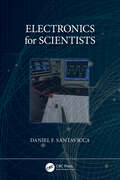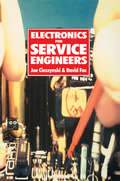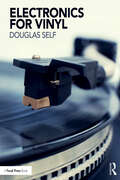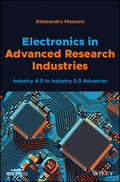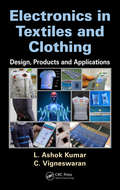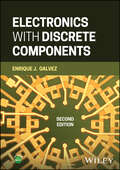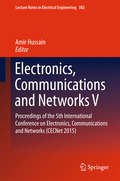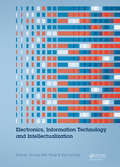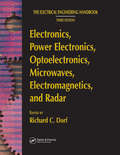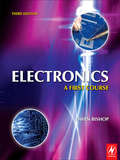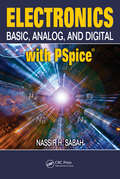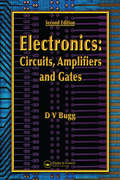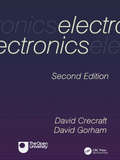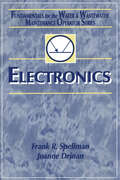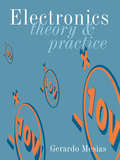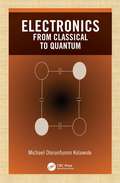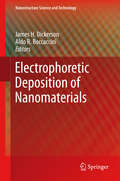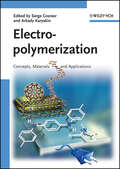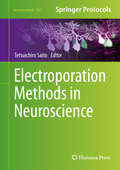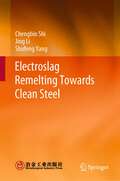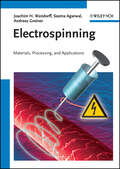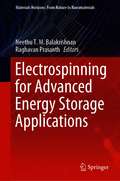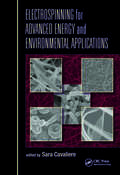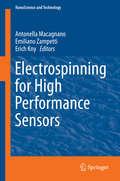- Table View
- List View
Electronics for Scientists
by Daniel F. SantaviccaElectronics for Scientists provides a practical and concise introduction to electrical circuits, signals, and instrumentation for undergraduate students in the physical sciences. No previous familiarity with electronics is required and concepts are grounded in the relevant physics. The book aims to give students the electronics background needed to be successful in experimental science. The book begins with the fundamentals of DC circuits. This is followed by AC circuits and their analysis using the concept of impedance. The transfer function is introduced and used to analyze different types of filter circuits. The conversion between time-domain and frequency-domain signal representations is reviewed. Transmission lines are introduced and used to motivate the different approach to designing microwave-frequency circuits as compared to lower-frequency circuits. The physics of semiconductors is reviewed and used to understand the behavior of diodes and transistors, and a number of diode and transistor circuits is analyzed. The operational amplifier (op-amp) is introduced and several op-amp circuits are analyzed. Techniques for quantifying noise in electrical measurements are described and common sources of noise are discussed. The last major topic is digital circuits, which include analog-to-digital conversion, logic gates, and digital memory circuits. The book concludes with a brief introduction to quantum computing. Designed for a one-semester course, this book brings together a range of topics relevant to experimental science that are not commonly found in a single text. Worked examples are provided throughout the book, and each chapter concludes with a set of problems to reinforce the material covered. The subject of electronics is indispensable to a wide array of scientific and technical fields, and this book seeks to provide an approachable point of access to this rich and important subject.
Electronics for Service Engineers
by Dave FoxElectronics for Service Engineers is the first text designed specifically for the Level 2 NVQs in Electronics Servicing. It provides the underpinning knowledge required by brown goods and white goods students, reflecting the popularity of the EMTA white goods NVQs. It has also been written in the light of the new EEB / City & Guilds Level 2 progression award (RVQ) for brown goods and commercial electronics, dubbed 'son of 2240', and the existing 2240 part 1. The wide ranging experience of the authors makes this a readable book with much relevance to the real-life challenges of the service engineer. From simple mathematics and circuit theory to transmission theory and aerials, from health and safety to logic gates and transducers, the complete range of knowledge required to service electronic and electrical equipment is here. This practical emphasis makes the book ideal for existing service engineers seeking to gain an NVQ. Numerous questions and worked examples throughout the text allow readers to monitor their own progress, and provide practice for C&G tests.Joe Cieszynski and Dave Fox have a wide mix of experience, both in the field and workshop working on TV and audio, and teaching electronic servicing and security installation at MANCAT. Joe writes regularly for Television magazine.
Electronics for Vinyl
by Douglas SelfElectronics for Vinyl is the most comprehensive book ever produced on the electronic circuitry needed to extract the best possible signal from grooves in vinyl. What is called the "vinyl revival" is in full swing, and a clear and comprehensive account of the electronics you need is very timely. Vinyl reproduction presents some unique technical challenges; the signal levels from moving-magnet cartridges are low, and those from moving-coil cartridges lower still, so a good deal of high-quality low-noise amplification is required. Some of the features of Electronics for Vinyl include: integrating phono amplifiers into a complete preamplifier; differing phono amplifier technologies; covering active, passive, and semi-passive RIAA equalisation and transconductance RIAA stages; the tricky business of getting really accurate RIAA equalisation without spending a fortune on expensive components, such as switched-gain MM/MC RIAA amplifiers that retain great accuracy at all gains, the effects of finite open-loop gain, cartridge-preamplifier interaction, and so on; noise and distortion in phono amplifiers, covering BJTs, FETs, and opamps as input devices, hybrid phono amplifiers, noise in balanced MM inputs, noise weighting, and cartridge load synthesis for ultimately low noise; archival and non-standard equalisation for 78s etc.; building phono amplifiers with discrete transistors; subsonic filtering, covering all-pole filters, elliptical filters, and suppression of subsonics by low-frequency crossfeed, including the unique Devinyliser concept; ultrasonic and scratch filtering, including a variety of variable-slope scratch filters; line output technology, including zero-impedance outputs, on level indication for optimal setup, and on specialised power supplies; and description of six practical projects which range from the simple to the highly sophisticated, but all give exceptional performance. Electronics for Vinyl brings the welcome news that there is simply no need to spend huge sums of money to get performance that is within a hair’s breadth of the best theoretically obtainable. But you do need some specialised knowledge, and here it is.
Electronics in Advanced Research Industries: Industry 4.0 to Industry 5.0 Advances
by Alessandro MassaroA one-of-a-kind examination of the latest developments in machine control In Electronics in Advanced Research Industries: Industry 4.0 to Industry 5.0 Advances, accomplished electronics researcher and engineer Alessandro Massaro delivers a comprehensive exploration of the latest ways in which people have achieved machine control, including automated vision technologies, advanced electronic and micro-nano sensors, advanced robotics, and more. The book is composed of nine chapters, each containing examples and diagrams designed to assist the reader in applying the concepts discussed within to common issues and problems in the real-world. Combining electronics and mechatronics to show how they can each be implemented in production line systems, the book presents insightful new ways to use artificial intelligence in production line machines. The author explains how facilities can upgrade their systems to an Industry 5.0 environment. Electronics in Advanced Research Industries: Industry 4.0 to Industry 5.0 Advances also provides: A thorough introduction to the state-of-the-art in a variety of technological areas, including flexible technologies, scientific approaches, and intelligent automatic systems Comprehensive explorations of information technology infrastructures that support Industry 5.0 facilities, including production process simulation Practical discussions of human-machine interfaces, including mechatronic machine interface architectures integrating sensor systems and machine-to-machine (M2M) interfaces In-depth examinations of internet of things (IoT) solutions in industry, including cloud computing IoT Perfect for professionals working in electrical industry sectors in manufacturing, production line manufacturers, engineers, and members of R&D industry teams, Electronics in Advanced Research Industries: Industry 4.0 to Industry 5.0 Advances will also earn a place in libraries of technicians working in the process industry.
Electronics in Textiles and Clothing: Design, Products and Applications
by L. Ashok Kumar C. VigneswaranThis book covers the basic fundamentals of electronics and their applications in textiles and clothing product development. With increasing awareness about the e-textiles, researchers and scientists are finding ways to treat the textile materials integrating with electronics for communication/signal transferring applications. The book discusses wearable electronics, fabric production techniques for wearable electronics, design of circuits and integration into wearable electronic fabrics, product development, software development, design and development of wearable electronic flexible solar tent, and garment integrated wearable electronic products.
Electronics with Discrete Components
by Enrique J. GalvezComprehensive textbook on electronics for physicists, now with more examples, exercises, hands-on electronics labs, troubleshooting tips, and practical exercises Electronics with Discrete Components delivers a comprehensive overview of electronics from the perspective of a physicist. In the first part on digital components, after an introduction to digital electronics, the text covers fundamentals of combinational logic and its implementation in combinational logic devices, followed by sequential-logic devices such as flip-flops and memory components. The second part on analog components deals with the fundamentals of signal processing, filters, components such as diodes and transistors, and a lengthy coverage of operational amplifiers. Each chapter ends with problem sets and “lab projects” that have been proven to work well for instruction. Questions on simple aspects of the lab that students should know are also included, such as regarding powering components and diagnosing signals with the oscilloscope and providing “troubleshooting tips” to help students find out why a particular circuit does not work. The new edition of this textbook adds more worked examples, exercises with answers for the self-learner, and end-of-chapter problems. It adds new electronic components, covers the latest digital technologies plus adds a new section of Fourier transforms in electronics. In addition, it features labs with Arduino or Teensy boards which have become widespread in the community as inexpensive, easy-to-use electronics platforms. Electronics with Discrete Components includes information on: Number systems, codes, signed numbers, binary functions, logic families, and IC wiringsFilters and the frequency domain, covering RC, high- and low-pass, and cascading filters, FFTs, as well as important considerations for filter designConnecting digital to analog and to the world through TTL, CMOS, and LV gates and interfacing between the logic familiesCharge and potential, capacitors, electrical current, resistors, magnetic components, power, circuits, and abstractions and symbol jargon in the field The Second Edition of Electronics with Discrete Components is an ideal textbook resource for a one-semester course on electronics for second-year physics students, as well as students from other disciplines or levels who understand elementary notions of circuits and complex numbers.
Electronics, Communications and Networks V
by Amir HussainThis book comprises peer-reviewed contributions presented at the 5th International Conference on Electronics, Communications and Networks (CECNet 2015), held in Shanghai, China, 12-15 December, 2015. It includes new multi-disciplinary topics spanning a unique depth and breadth of cutting-edge research areas in Electronic Engineering, Communications and Networks, and Computer Technology. More generally, it is of interest to academics, students and professionals involved in Consumer Electronics Technology, Communication Engineering and Technology, Wireless Communication Systems and Technology, and Computer Engineering and Technology.
Electronics, Information Technology and Intellectualization: Proceedings of the International Conference EITI 2014, Shenzhen, China, 16-17 August 2014
by Kyung Sup Kwak Young Min SongThe International Conference on Electronics, Information Technology and Intellectualization (ICEITI2014) was dedicated to build a high-level international academic communication forum for international experts and scholars. This fi rst conference of an annual series was held in Pengcheng, Shenzhen, China 16-17 August 2014. Many prestigious experts
Electronics, Power Electronics, Optoelectronics, Microwaves, Electromagnetics, and Radar (The Electrical Engineering Handbook)
by Richard C. DorfIn two editions spanning more than a decade, The Electrical Engineering Handbook stands as the definitive reference to the multidisciplinary field of electrical engineering. Our knowledge continues to grow, and so does the Handbook. For the third edition, it has expanded into a set of six books carefully focused on a specialized area or field of study. Electronics, Power Electronics, Optoelectronics, Microwaves, Electromagnetics, and Radar represents a concise yet definitive collection of key concepts, models, and equations in these areas, thoughtfully gathered for convenient access. Electronics, Power Electronics, Optoelectronics, Microwaves, Electromagnetics, and Radar delves into the fields of electronics, integrated circuits, power electronics, optoelectronics, electromagnetics, light waves, and radar, supplying all of the basic information required for a deep understanding of each area. It also devotes a section to electrical effects and devices and explores the emerging fields of microlithography and power electronics. Articles include defining terms, references, and sources of further information. Encompassing the work of the world’s foremost experts in their respective specialties, Electronics, Power Electronics, Optoelectronics, Microwaves, Electromagnetics, and Radar features the latest developments, the broadest scope of coverage, and new material in emerging areas.
Electronics: A First Course
by Owen BishopOwen Bishop’s First Course starts with the basics of electricity and component types, introducing students to practical work almost straight away. No prior knowledge of electronics is required. The approach is student-centred with self-test features to check understanding, including numerous activities suitable for practicals, homework and other assignments. Multiple choice questions are incorporated throughout the text in order to aid student learning. Key facts, formulae and definitions are highlighted to aid revision, and theory is backed up by numerous examples within the book. Each chapter ends with a set of problems that includes exam-style questions, for which numerical answers are provided at the end of the book. This text is ideal for a wide range of introductory courses in electronics, technology, physics and engineering. The coverage has been carefully matched to the latest UK syllabuses including GCSE Electronics, GCSE Design & Technology, Engineering GCSE and Edexcel’s BTEC First in Engineering, resulting in a text that meets the needs of students on all Level 2 electronics units and courses. Owen Bishop’s talent for introducing the world of electronics has long been a proven fact with his textbooks, professional introductions and popular circuit construction guides being chosen by thousands of students, lecturers and electronics enthusiasts.
Electronics: Basic, Analog, and Digital with PSpice
by Nassir H. Sabah<p>Electronics: Basic, Analog, and Digital with PSpice does more than just make unsubstantiated assertions about electronics. Compared to most current textbooks on the subject, it pays significantly more attention to essential basic electronics and the underlying theory of semiconductors. <p>In discussing electrical conduction in semiconductors, the author addresses the important but often ignored fundamental and unifying concept of electrochemical potential of current carriers, which is also an instructive link between semiconductor and ionic systems at a time when electrical engineering students are increasingly being exposed to biological systems. <p>The text presents the background and tools necessary for at least a qualitative understanding of new and projected advances in microelectronics. The author provides helpful PSpice simulations and associated procedures (based on schematic capture, and using OrCAD® 16.0 Demo software), which are available for download. These simulations are explained in considerable detail and integrated throughout the book. The book also includes practical, real-world examples, problems, and other supplementary material, which helps to demystify concepts and relations that many books usually state as facts without offering at least some plausible explanation. <p>With its focus on fundamental physical concepts and thorough exploration of the behavior of semiconductors, this book enables readers to better understand how electronic devices function and how they are used. The book’s foreword briefly reviews the history of electronics and its impact in today’s world.</p>
Electronics: Circuits, Amplifiers and Gates, Second Edition
by D.V. BuggIntroduced more than a decade ago, the first edition of D.V. Bugg's Electronics: Circuits, Amplifiers and Gates became widely popular for its comprehensive yet concise coverage of all the major introductory topics in electronics. Today, semiconductor chips and integrated circuits are used universally. This second edition was revised and streamlined to focus on the basic principles required to apply this extensive technology.Electronics: Circuits, Amplifiers and Gates, Second Edition offers a complete introduction to the fundamentals of AC and DC circuits along with complex numbers, bandwidth, and operational amplifiers. It includes a description of the working principles of transistors, outlining doping and the operation of the diode, bipolar transistor, and field effect transistor. The book also features a section on digital logic and concludes with more advanced chapters describing resonance and transients and their relation through Fourier analysis.Updated to reflect advances in the field over the past decade, Electronics: Circuits, Amplifiers and Gates, Second Edition is fully illustrated throughout with numerous worked examples and sample problems.
Electronics: Circuits, Systems And Signal Processing
by David Crecraft David GorhamProviding an introduction to good engineering practice for electrical and electronic engineers, this book is intended for first- and second-year undergraduate courses. It deals with engineering practice in relation to important topics such as reliability and maintainability, heat management and parasitic electrical effects, environmental influences, testing and safety. The coverage encompasses the properties, behaviour, fabrication and use of materials and components used in the fields of computing, digital systems, instrumentation, and control. The second edition has been revised extensively to reflect advances in technology, with new material on insulation-displacement jointing and electrical-safety testing.
Electronics: Fundamentals for the Water and Wastewater Maintenance Operator
by Frank R. Spellman Joanne DrinanThis is the only book series devoted to explaining the full range of specialized areas required of water and wastewater plant operators. Each volume is designed to give operators the basic knowledge of a subject needed for certification, licensure, and improved job performance. Checkpoints, self-tests and a final examination with questions based on
Electronics: Theory and Practice
by Gerardo MesiasElectronics Theory and Practice introduces the key areas of analog electronics through practicals, worked examples and concise explanations. The author is a senior lecturer at De Montfort University and his approach is a proven way of teaching the essentials of electronics to groups with a variety of academic backgrounds. This is an ideal text for first year modules and HNC/D units - comprehensive, concise and affordable.
Electronics: from Classical to Quantum
by Michael Olorunfunmi KolawoleThis book gives clear explanations of the technical aspects of electronics engineering from basic classical device formulations to the use of nanotechnology to develop efficient quantum electronic systems. As well as being up to date, this book provides a broader range of topics than found in many other electronics books. This book is written in a clear, accessible style and covers topics in a comprehensive manner. This book’s approach is strongly application-based with key mathematical techniques introduced, helpful examples used to illustrate the design procedures, and case studies provided where appropriate. By including the fundamentals as well as more advanced techniques, the author has produced an up-to-date reference that meets the requirements of electronics and communications students and professional engineers. Features Discusses formulation and classification of integrated circuits Develops a hierarchical structure of functional logic blocks to build more complex digital logic circuits Outlines the structure of transistors (bipolar, JFET, MOSFET or MOS, CMOS), their processing techniques, their arrangement forming logic gates and digital circuits, optimal pass transistor stages of buffered chain, sources and types of noise, and performance of designed circuits under noisy conditions Explains data conversion processes, choice of the converter types, and inherent errors Describes electronic properties of nanomaterials, the crystallites’ size reduction effect, and the principles of nanoscale structure fabrication Outlines the principles of quantum electronics leading to the development of lasers, masers, reversible quantum gates, and circuits and applications of quantum cells and fabrication methods, including self-assembly (quantum-dot cellular automata) and tunneling (superconducting circuits), and describes quantum error-correction techniques Problems are provided at the end of each chapter to challenge the reader’s understanding
Electrophoretic Deposition of Nanomaterials
by Aldo R. Boccaccini James H. DickersonThis book provides a comprehensive overview of contemporary basic research, emerging technology, and commercial and industrial applications associated with the electrophoretic deposition of nanomaterials. This presentation of the subject includes an historical survey, the underlying theory of electrophoresis, dielectrophoresis, and the colloidal deposition of materials. This is followed by an assessment of the experimental equipment and procedures for electrophoretic and dielectrophoretic aggregation, manipulation, and deposition of nanoparticles, nanotubes, and other nanomaterials. Additional chapters explore the specific science and technology of electrophoretic film formation, using widely studied and application-driven nanomaterials, such as carbon nanotubes, luminescent nanocrystals, and nano-ceramics. The concluding chapters explore industrial applications and procedures associated with electrophoretic deposition of nanomaterials.
Electroplating and Electroforming: A Guide For The Craftsman
by Lee Newman Jay H. NewmanReviews the history, materials, and techniques of electroplating and electroforming, current craft and commercial processes, and contemporary forms, outlining instructions for a number of creative projects
Electropolymerization: Concepts, Materials and Applications
by Serge Cosnier Arkady KaryakinProviding extensive coverage, including conducting, insulating and electroactive films, this handbook and ready reference deals with introductory topics and fundamentals as well as advanced insights. Clearly structured, in the first part of the book readers learn the fundamentals of electropolymerizatoin for all important types of polymers, mechanisms of film formation and functionalization, while the second part covers a wide range of applications in biochemistry, analytics, photovoltaics, energy and the environment as well as actuators.
Electroporation Methods in Neuroscience
by Tetsuichiro SaitoThis volume describes the methods of both in vivo and in vitro electroporation using ferrets, rats, mice, chickens, and zebrafish. Recent advances of experiments using the tetracycline-regulated gene expression and Tol2 transposon systems are also included. Written in the popular Neuromethods series style, chapters include the kind of detail and key advice from the specialists needed to get successful results in your own laboratory. Practical and authoritative, Electroporation Methods in Neuroscience serves to aid scientists in the further study into this crucially important way to study cells.
Electroslag Remelting Towards Clean Steel
by Jing Li Chengbin Shi Shufeng YangThis book introduces the results that the authors have achieved on the study of functional principle of electroslag remelting for production of high-quality clean steel. The dependence of oxygen, sulfur, and non-metallic inclusions on the processing parameters of electroslag remelting is assessed. The fundamentals and technologies of clean steel production by electroslag remelting have been applied in the round to discuss oxygen, sulfur, and non-metallic inclusions evolution and control. A general concluding remark and a perspective for future work are present. The book is likely to be of interest to university teachers, researchers, R&D engineers, and graduate students in material processing and pyrometallurgy who wish to explore innovative technologies that lead to more energy-efficient and environmentally sustainable clean steel production.
Electrospinning
by Andreas Greiner Seema Agarwal Joachim H. WendorffElectrospinning is from the academic as well as technical perspective presently the most versatile technique for the preparation of continuousnanofi bers obtained from numerous materials including polymers, metals, and ceramics. Shapes and properties of fibers can be tailoredaccording to the demand of numerous applications including filtration, membranes, textiles, catalysis, reinforcement, or biomedicals.This book summarizes the state-of-the art in electrospinning with detailed coverage of the various techniques, material systems and theirresulting fiber structures and properties, theoretical aspects and applications.Throughout the book, the current status of knowledge is introduced with a critical view on accomplishments and novel perspectives. Anexperimental section gives hands-on guidance to beginners and experts alike.
Electrospinning for Advanced Energy Storage Applications (Materials Horizons: From Nature to Nanomaterials)
by Raghavan Prasanth Neethu T. M. BalakrishnanThis book provides a consolidated description of the process of electro-spinning and detailed properties and applications of electro-spun electrodes and electrolytes in energy storage devices. It discusses the preparation, structure and electrochemical properties of nanofiber electrode and electrolyte materials. It focuses exclusively on Lithium Ion batteries, with the contents discussing different aspects of electrospinning in storage systems. This book aims to provide a comprehensive resource to help researchers choose the best electrodes and electrolyte materials based on the properties required for their desired commercial applications. It will be a useful guide to graduate students and researchers working in solid-state chemistry, physics, materials chemistry, and chemical engineering on aspects of energy storage.
Electrospinning for Advanced Energy and Environmental Applications
by Sara CavaliereElectrospinning for Advanced Energy and Environmental Applications delivers a state-of-the-art overview of the use of electrospun fibers in energy conversion and storage, as well as in environmental sensing and remediation. It first introduces electrospinning and its origins, outlining achievable one-dimensional nanoscaled materials and their applications. It then discusses the use of electrospun materials in energy devices, including low- and high-temperature fuel cells, hydrogen storage, dye-sensitized solar cells, lithium-ion batteries, and supercapacitors. It also explores environmental applications, such as the use of electrospinning-issued materials in membranes for water and air purification, and in sensors and biosensors for pollution control.
Electrospinning for High Performance Sensors
by Antonella Macagnano Emiliano Zampetti Erich KnyThis book aims to present the different aspects of electrospinning for designing and fabricating high performing materials for sensors applied in gaseous and liquid environments. Since electrospinning is a versatile and inexpensive manufacturing technology, the book emphasizes the industrial applications perspective. The volume is an edited collection of the most recent and encouraging results concerning advanced nanostructured (bio) sensors. The feats achieved by these sensors range from high sensitivity to extreme operating conditions and satisfy a wide range of requirements. Most of the contributions in this book come from First International Workshop on "Electrospinning for High Performance Sensing "(EHPS2014) that was held in Rome in 2014, as part of the European COST Action MP1206 "Electrospun Nanofibres for bio inspired composite materials and innovative industrial applications. "
